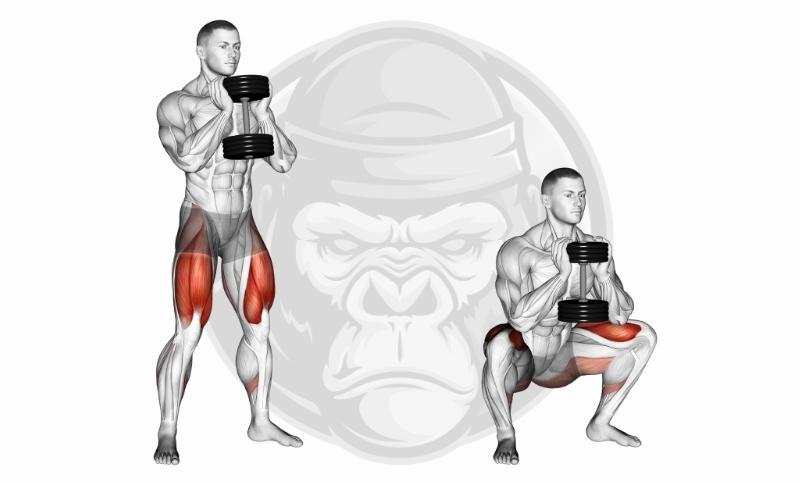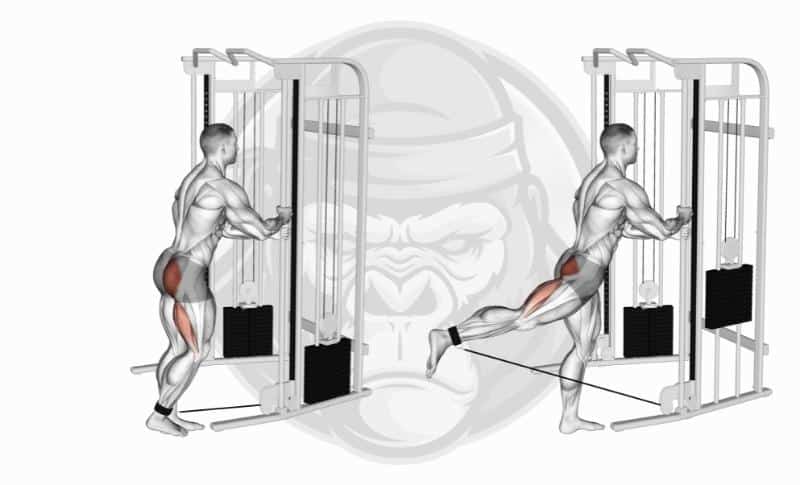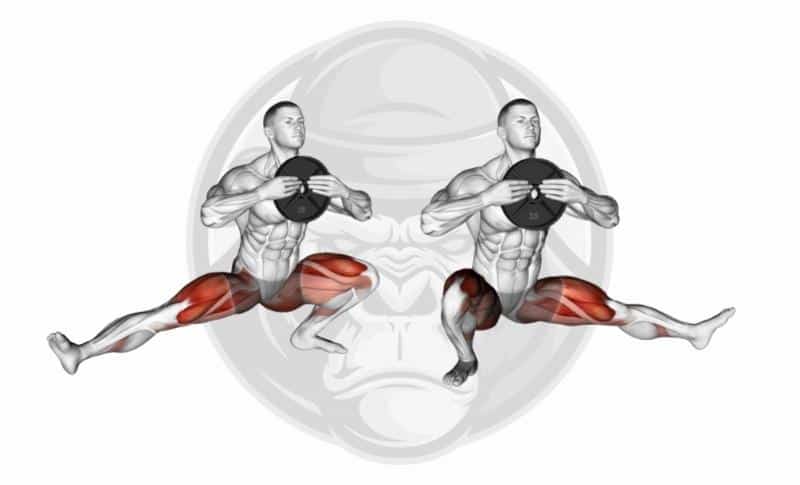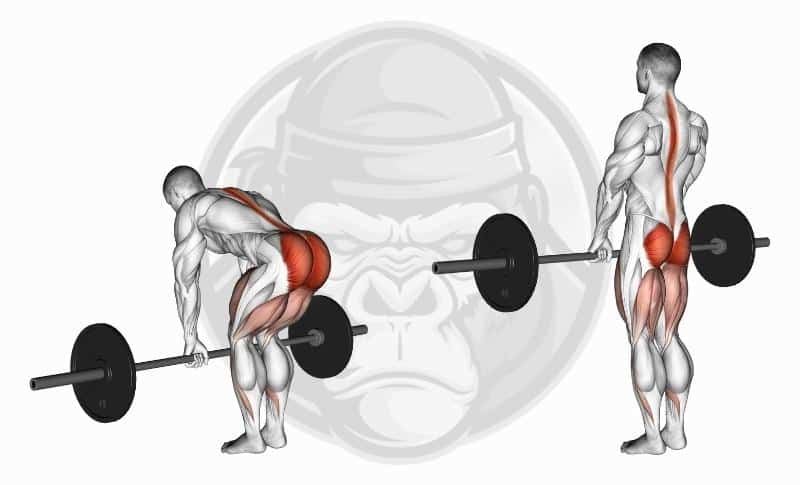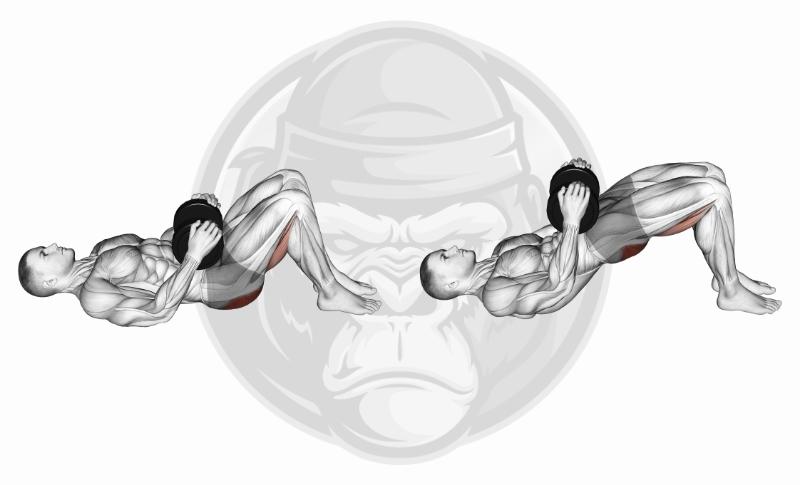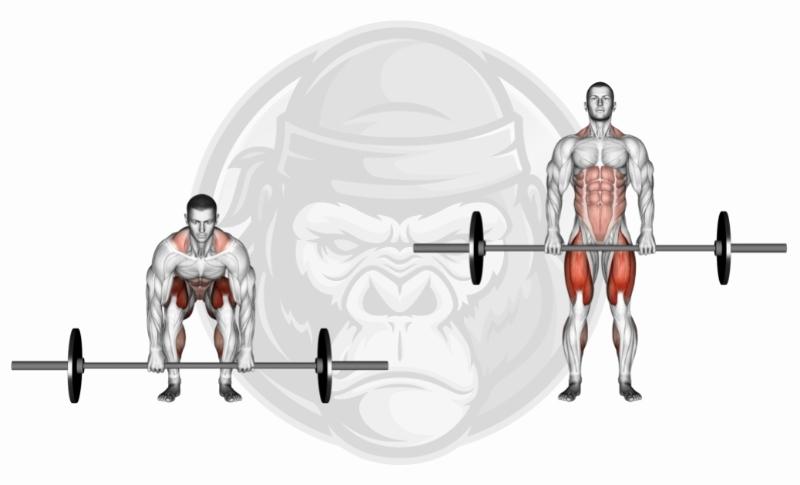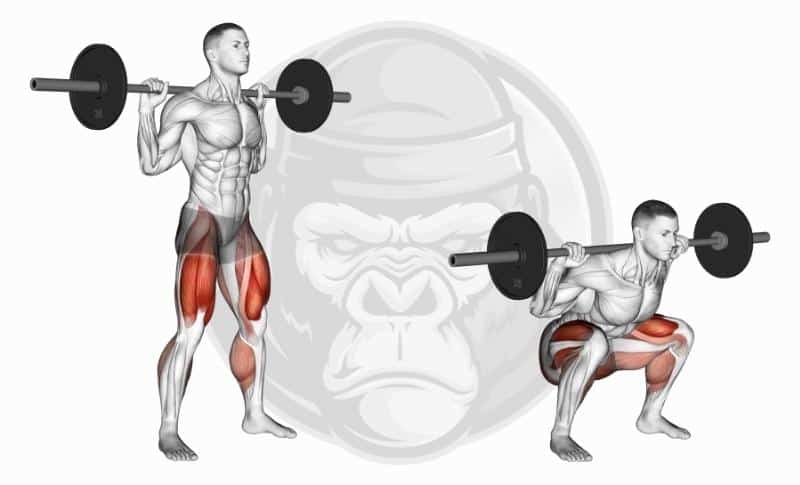Training
The 10 Best Glute Exercises
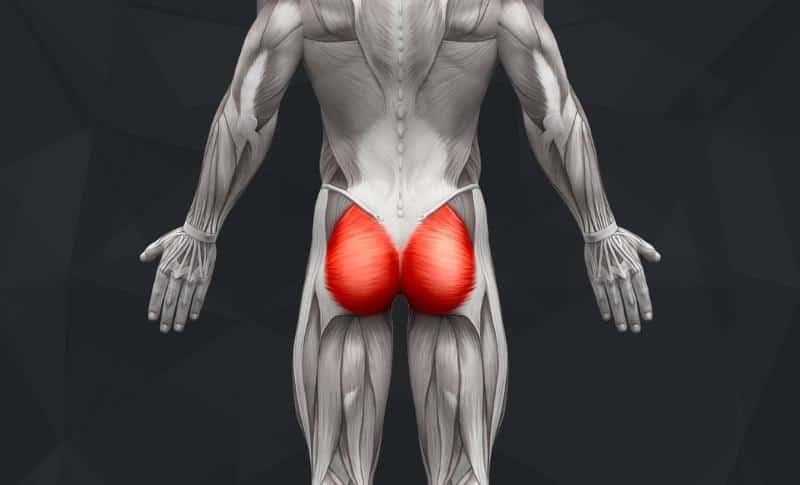
What are the best glute exercises?
It’s no secret that performing the best glute exercises is essential to achieving the gluteus maximus you’ve dreamed about.
It’s time to step up the glute exercises and make those dreams a reality.
Glutes are really just a fancy way of saying the butt (for those new here!), and they’re one of the most important muscles in your body to train.
Develop strong buns, and you can train harder, longer, and heavier.
The gluteus maximus and gluteus medius make up the majority of the muscles in the glute and are responsible for the shape and strength of the butt.
Ready to develop buns of steel? Keep reading!
The Best Glute Exercises
Our exercise lists are created by determining the best exercises for muscle growth, core strength, and overall health and well-being.
Here’s our list of the 10 best glute exercises:
10. Goblet Squats
Great for:
Beginners looking to perfect their form and transition to weighted squats.
How to do it:
- Stand holding a dumbbell with your feet shoulder-width apart
- Tuck your elbows in and hold the weight at chest-level
- Squat down, so your knees reach a 90-degree angle
- Stand up and repeat as desired
Why:
Goblet squats are known to strengthen the muscles in the legs and for building stamina in any leg and butt workout.
These squats assist with working the hip flexors, which support hip extension during movement.
When:
If you’re just getting into glute workouts and want to build strong form first, goblet squats are an essential move.
They train your body and build muscle memory, ensuring your technique is pristine, and each muscle is activated.
9. Kickbacks
Great for:
A glute workout that works one leg at a time, allowing for muscle balancing.
How to do it:
- Get onto all fours on a mat
- Engage your core muscles and elongate your spine
- Kick your right leg back, so it’s parallel with the floor
- Squeeze your glutes when your leg is straight and hold for two seconds
- Move your leg back to the starting position without touching the floor
- Repeat on the same leg
- Switch to your left leg and repeat the movement
Why:
To effectively work the glutes and hamstrings, kickbacks are a solid choice.
They also help with maintaining a strong posture throughout your back, and strengthening these muscles will assist with climbing and lifting heavy things in and out of the gym.
When:
Workouts with minimal or no equipment can be performed anywhere from three to five times a week.
Once your balance is established, and you feel comfortable with the movement, try completing a set of 12 to 15 reps on each leg.
Remember — the goal with kickbacks is to work each leg individually and maintain a flat back throughout the exercise.
8. Cossack Squats
Great for:
Building one glute muscle at a time and increased flexibility.
How to do it:
- Take a wide stance and angle your toes out
- Shift your weight to one side
- Keep your back straight and slowly sit your hips down
- Lower your body as far as your mobility allows
- Drive your feet through the floor and stand up
- Repeat as desired
Why:
Cossack squats target the gluteus medius, quads, inner thighs, hamstrings, and calves.
They engage the core, making it an effective glute workout that activates many other muscle groups throughout this exercise.
Because of the stance, your balance will be challenged throughout the squatting movement.
Due to the deeper range of motion in a Cossack squat, hip mobility and strength are also trained during this move.
When:
Cossack squats are a great choice to warm up the glute muscles for a leg and butt workout.
With the gluteus medius warm, other squat variations can be done more effectively because the muscles are activated and ready to work.
To warm up, complete 10 to 15 reps on each side, getting a good lower body stretch in as you squat on each leg.
7. Sumo Deadlifts
Great for:
Targeting the smaller glute muscles through external hip rotation.
How to do it:
- Stand with your toes pointed out at a 30-degree angle, hip-width apart
- Hinge your hips as you reach down to grab the bar
- Drive your feet into the floor and lift the bar, squeezing the glutes as you lift
- Keep your back straight and your spine neutral
- Hinge at the hips again to lower the bar to the floor
- Repeat as desired
Why:
If adding strength and sculpting the glutes and lower body is on your To-Do list, Sumo deadlifts should definitely be included in your lower body routine.
Because your feet are angled out at around 30 degrees, this creates tension for the glutes and specifically targets the gluteus medius and minimus, the smaller of the three glute muscles.
Sumo deadlifts also target the quads and adductors.
When:
Sumo deadlifts can be worked into any leg or butt routine.
And, depending on how heavy the weights you’re using are, they can be a relatively low-impact exercise if you train your back muscles to stay strong and straight.
If you’re new to deadlifts, work on getting your form perfected before focusing too much on how heavy you are lifting.
Technique is what will train the muscles to perform while keeping your posture intact.
6. Lateral Lunges
Great for:
Targeting the gluteus medius and minimus through hip rotations.
How to do it:
- Step one leg out to the side about 2 feet, with your foot planted
- Hold a dumbbell or kettlebell in the hand opposite of the bent leg
- Keep your other leg stationary and your foot facing forward
- Perform a side lunge by driving your bent knee forward while your body tracks to the side
- Move your body back to the starting position
Why:
To challenge the muscles that assist the hips with movement and rotation, lateral motion is essential.
The side-to-side movement activates those hard-to-reach hip muscles and wakes them right up.
Lateral lunges also require the effort of one leg at a time, allowing for an even distribution of weight on each leg and to even out any unbalanced muscles on one leg over the other.
When:
Once you have the correct motion, lateral lunges can be a great addition to any leg circuit training workout you do in the gym or at home.
Since they require minimal equipment and space, you’ll find these are great exercises to do when warming up or during any leg and butt routine.
Focus on moving slowly to activate the muscles in your hips and butt, and you’ll get a great burn.
5. Romanian Deadlifts
Great for: a strength move that targets the glutes, hamstrings, and core.
How to do it:
- Begin by standing with the barbell or dumbbells at your hips
- Push your hips and glutes back slightly, with a loose bend in the knee
- Bend forward, keeping the weights close to your body
- Go down as far as you can without losing the proper form (straight back, neutral spine)
- Squeeze your glutes, drive your hips forward, and stand back up
- Repeat as desired
Why:
For an intense exercise that emphasizes the glutes and hamstrings, Romanian deadlifts are a clear choice.
Lowering the weight down against gravity instead of pulling it up creates a different challenge for the glutes and hamstring.
Because your range of motion is smaller during a Romanian deadlift, the glute muscles are isolated and heavily targeted to work throughout the move.
When:
Romanian deadlifts can be incorporated into your leg day routine, in the gym, or at home.
If you’re using a barbell or dumbbells, start with a lighter weight than what you typically use on deadlifts and add weight as you gain strength.
4. Glute Bridges
Great for:
Time under tension for the glute muscles.
How to do it:
- Place a loaded barbell on your hips
- Sit with your upper back resting on the lower part of a bench
- Bend your knees with your feet driving into the floor
- Drive your hips up, with your body in a straight line from chin to knees
- Pause for one second, then lower the bar down with your body
- Repeat as desired
Why:
To directly target the glutes in a great burner exercise, glute bridges are the way to go.
Glute bridges also allow for a heavier lift without straining the back or spine, making these a great addition to your butt or leg day workouts.
When:
Because the range of motion on a glute bridge is much smaller than other exercises, you’ll feel the burn after just a few reps.
Try completing two sets of 8 to 10 reps, paying close attention to your form and how your back feels during each bridge. Scale-up from there.
3. Conventional Deadlifts
Great for:
A full-body workout while targeting the muscles surrounding the hips, knees, and ankles.
How to do it:
- Hinge at the hips as you reach down for the bar, with your feet hip-width apart
- Make sure your feet are planted firmly on the floor as you grab the bar
- Drive your feet into the floor using your quads and lift the bar, keeping your back straight
- Lift the bar to about hip height, pause for one second, then slowly lower it to the floor
- Repeat as desired
Why:
There are few exercises that can activate nearly every muscle in the lower body while also providing a full-body strength workout.
Deadlifts can truly do it all, and that’s why they’re the go-to exercise for many weightlifters and athletes of any caliber.
Deadlifts also help with training grip strength as you lift, so if you want to focus on a better, stronger grip during any exercise, let it be this one.
When:
With a primary emphasis on hip extensions, conventional deadlifts can be incorporated into any leg or back workout circuit.
Start with five to seven reps per set, adding weight as you build strength and endurance.
2. Hip Thrusts
Great for:
Targeting the posterior chain muscles and stabilizing the core.
How to do it:
- Sit with your back against a bench with your knees bent and your feet flat on the floor
- Rest your elbows on the bench
- Push through your heels until your thighs are parallel with the floor
- Squeeze your glutes as you lift, and once you reach the top
- Lower your body down a few inches from the floor
- Repeat as desired
Why:
If you’re on a mission to add size and strength to your glutes, hip thrusts can get you there with consistency and proper form.
Hip thrusts support movements like running and jumping, while also promoting overall mobility in the hips and legs.
When:
Hip thrusts can be done in your home gym or at a commercial gym, using any type of bench to support your back and hips.
Because of their versatility, you can add hip thrusts to any full-body workout or leg day specifically.
Start with three sets of 10 to 12 reps, and gradually work your way up using bodyweight and eventually weights.
Make sure to give your muscles a chance to recover, so try incorporating this move three times a week and resting in between.
Here are our favorite massage guns for recovery days.
1. Back Squats
Great for:
Building strength and targeting the glute muscles in a fully stretched movement.
How to do it:
- Set a barbell to about shoulder height on a power rack
- Stand with the barbell resting on your upper back and shoulders
- Bend your knees slightly and lift the weight off the rack
- Slowly move backward a few steps
- With the bar on your back, squat down slowly
- Stand back up, driving your feet into the floor
- Repeat as desired
Why:
There’s a reason back squats are the #1 glute workout on our list — they provide a killer burn for the butt muscles in a way that can’t be replaced by any other weighted exercise.
The deep squat performed in this move creates a full stretch motion, isolating the glutes and activating all three muscles there.
Additionally, the core remains engaged throughout this move, strengthening the abdominal muscles as well.
When:
While you do need a power rack to perform back squats, we recommend doing this exercise two to three times a week to achieve the results you want for your glutes.
Start slowly with a few reps at a time, ensuring you’re comfortable with the movement before scaling up.
FAQs About Glute Exercises
To leave you feeling fully prepared about the best glute exercises you should be doing, here are our answers to some commonly asked questions about glute exercises.
Q: What is the function of the glutes?
The primary functions of the glute muscles are to support hip extension, internal rotation, and abduction of the hips (moving the hip away from the body).
Q: Why are glutes so important?
The glute muscles are important because they keep us upright and our bodies moving forward. They provide stability for the hips and help us balance.
It’s important to exercise the glutes because of the pivotal role they play in maintaining the body’s strength and posture.
Strong glutes can help prevent knee and back pain. They support lower back strength by assisting with the motions of the hip, pelvis, and trunk.
Q: When should I exercise my glutes?
In order to promote muscle recovery and rest, work your glutes using the exercises listed two or three times a week.
Rest days are just as important as workout days, so don’t overtrain your glutes (or any muscle) and risk injury or strain.
Q: Is it ok to work your glutes every day?
The legs, back, and butt require rest days to allow the muscles time to recover.
If you work your glutes every day, you run the risk of overstraining the muscles in your lower back, which can lead to injury.
While training the glutes every day may seem like a good idea, rest days are essential for recovery and muscle repair.
Q: What is the best exercise for your glutes?
The best glutes workout targets the specific muscle group that promotes hypertrophy and strength while getting a great burn.
The glutes muscle should remain activated throughout any exercise you’re doing to strengthen that particular muscle group.
The best exercise to work the gluteus maximus is back squats. They work the glute muscles and provide a full-body stretch as well. It’s a win-win!
Summary
The best glute exercises are the ones that leave you feeling challenged, a little shaky, and ready for more.
If building strong glutes is on your To-Do list, this post covers the best glute workouts you can do to strengthen and sculpt a butt you’re proud of.
Here’s a quick recap of the 10 best glute exercises:
- Back Squats
- Hip Thrusts
- Conventional Deadlifts
- Glute Bridges
- Romanian Deadlifts
- Lateral Lunges
- Sumo Deadlifts
- Cossack Squats
- Kickbacks
- Goblet Squats

